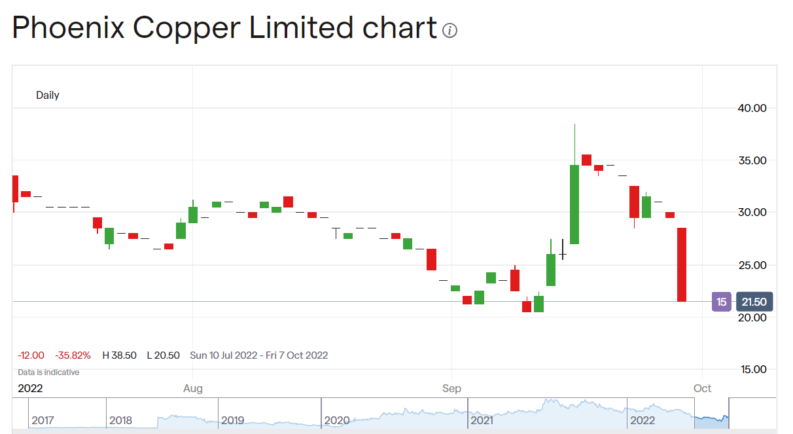Key points:
- Phoenix Copper is badly hit by market volatility
- Changeable prices means that it's not possible to nail down the feasibility study
- Without that there's no finance – a certain limbo awaits
Phoenix Copper (LON: PXC) (OTCQX: PXCLF) shares are down 27% this morning on the back of their interims. The actual results at Phoenix aren't that bad, exploration and development proceed and so on. The problem is that the wider markets are extremely volatile. This means that putting together the funding package for the next stage of development is, well, it's very difficult. This is just one of those problems with junior miners, it's not just about minerals and holes in the ground. Money matters – even money talks in this sector.
It's worth stepping back a bit to see what the problem is here. If we want to go and mine something then we've first got to decide what it is that we're going to go and mine. Coal in the UK looks like a bit of a non-starter, tin, rare earths or lithium look more fun. Then we've got to go and find a deposit of such that can be mined. Then prove it – show, by drilling, processing test batches of the mineral and so on – that it can be extracted and a profit made. All of that, to this stage, will be funded by equity capital.
Once we have proven, to a certain legal and economic standard, that mining this deposit is going to be – well, highly likely – profitable then we've got what is called a “bankable feasibility study”. This is the document off which the money to actually go mining, rather than exploring, is raised. It's the preparation of this that Phoenix Copper has problems with.

Also Read: The Best Copper and Mining Stocks to Watch in 2022
As the announcement in the interims says:”Copper and sterling have both been extremely volatile, and currently sit at around 30% below their highs for the year. The aftermath of Covid and the war in Ukraine, with the associated effects on energy prices, reagent costs and steel supply, have made it nearly impossible to complete an accurate feasibility study,”
Well, if the copper price is off 30% then of course copper mining becomes less profitable. If you can't get an accurate fix on costs then building an accurate model of costs and revenues doesn't work either. It's also worth noting that copper prices are down that 30% before the effects of inflation – but costs will be up by about inflation, say 10% at present.
Sterling's weakness is a different problem. A weaker pound means that earnings in USD – which is what there would be – are worth more. But we're raising sterling to try to gain those earnings, so we've got to raise more to gain them. A further problem.
The difficulty at Phoenix is that they may well have a perfectly good copper project there. But the emphasis is on the “may” there. Currently they can't prove it – and proof, or at least proving in a slightly different sense, is what is required to raise the finance to be able to go mining.
Which leaves the valuation of Phoenix Copper somewhat indeterminate. What will copper, sterling, equipment costs all be when the dust settles from the current market volatility? That's what will determine whether the project is a goer or not – so, that's the decision that has to be made about taking a position in PXC.
